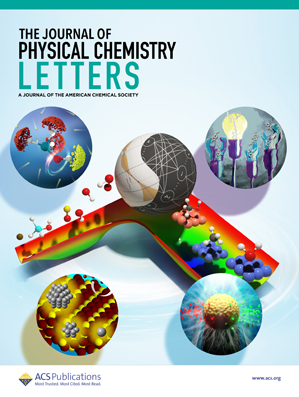Unraveling the Nature of Vibrational Dynamics in CsPbI3 by Inelastic Neutron Scattering and Molecular Dynamics Simulations.
IF 4.8
2区 化学
Q2 CHEMISTRY, PHYSICAL
引用次数: 0
Abstract
Cesium lead iodide, CsPbI3, is an optoelectronic material of large interest for various technological applications; however, fundamental questions surrounding the vibrational dynamics of this material, especially regarding its role in structural phase transitions, remain to be elucidated. Here, in a combined variable temperature inelastic neutron scattering (INS) and machine-learning based molecular dynamics (MD) simulation study, we show that the stable phase at room temperature, i.e., the nonperovskite δ-phase, exhibits phonon modes with weak anharmonicity with only a weak temperature dependence from 10 K all the way up to the transition to the cubic perovskite α-phase at approximately 600 K. In contrast, the α-phase features anharmonic and damped vibrational dynamics, mainly associated with overdamped tilting motions of the PbI6 octahedra. Crucially, these overdamped tilting modes, which relate to the tetragonal and orthorhombic distorted perovskite phases (β- and γ-phase, respectively) formed at lower temperatures, stay overdamped by more than 100 K above the respective phase transition. This suggests a flat energy landscape of octahedral tilting motions in α-CsPbI3 and with structural fluctuations on the picosecond time scale with tilting patterns that locally resemble the structure of the β- and γ-phases. The vibrational dynamics of α-CsPbI3 are also characterized by pronounced anharmonic motions with large thermal displacements of the Cs+ ions, but these modes remain underdamped at 600 K.用非弹性中子散射和分子动力学模拟揭示CsPbI3的振动动力学性质。
碘化铯铅(CsPbI3)是一种广泛应用于各种技术的光电材料;然而,围绕这种材料的振动动力学的基本问题,特别是关于其在结构相变中的作用,仍有待阐明。在此,通过结合变温非弹性中子散射(INS)和基于机器学习的分子动力学(MD)模拟研究,我们发现室温下的稳定相,即非钙钛矿δ相,表现出弱非谐性的声子模式,从10 K一直到大约600 K时向立方钙钛矿α-相过渡,只有弱的温度依赖性。相比之下,α-相具有非谐波和阻尼的振动动力学,主要与PbI6八面体的过阻尼倾斜运动有关。至关重要的是,这些与在较低温度下形成的四方和正交畸变钙钛矿相(分别为β-和γ-相)相关的过阻尼倾斜模式,在各自的相变之上保持超过100 K的过阻尼。这表明α-CsPbI3的八面体倾斜运动具有平坦的能量格局,并且在皮秒时间尺度上存在结构波动,倾斜模式局部类似于β相和γ相的结构。α-CsPbI3的振动动力学也表现为明显的非调和运动,Cs+离子的热位移较大,但这些模式在600 K时仍处于欠阻尼状态。
本文章由计算机程序翻译,如有差异,请以英文原文为准。
求助全文
约1分钟内获得全文
求助全文
来源期刊

The Journal of Physical Chemistry Letters
CHEMISTRY, PHYSICAL-NANOSCIENCE & NANOTECHNOLOGY
CiteScore
9.60
自引率
7.00%
发文量
1519
审稿时长
1.6 months
期刊介绍:
The Journal of Physical Chemistry (JPC) Letters is devoted to reporting new and original experimental and theoretical basic research of interest to physical chemists, biophysical chemists, chemical physicists, physicists, material scientists, and engineers. An important criterion for acceptance is that the paper reports a significant scientific advance and/or physical insight such that rapid publication is essential. Two issues of JPC Letters are published each month.
 求助内容:
求助内容: 应助结果提醒方式:
应助结果提醒方式:


